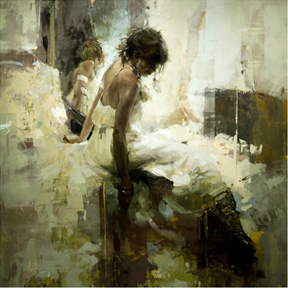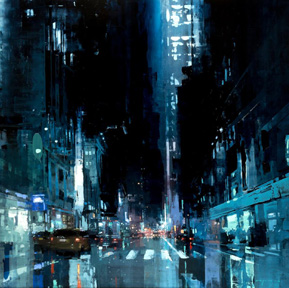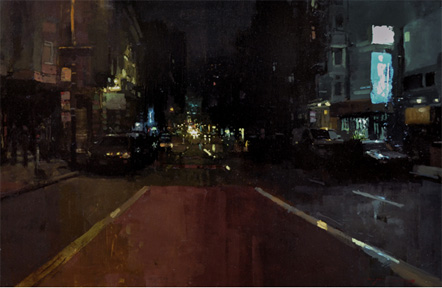

All images including header (detail) by Jeremy Mann, and used by permission of Principle Gallery.
By Brad Hawks
Fri, Nov 6, 2015
16:00ET
There aren't many artists who can post a painting on Facebook on a Friday afternoon and have several thousand likes within a few hours, accompanied by a steady stream of adoring comments, and women in Europe proclaiming "Impressionismo!" In fact, there may only be one American artist who enjoys this kind of attention, and that's Bay Area based painter Jeremy Mann.
In addition to his enthusiastic Facebook following, Mann has recently been the subject of an independent documentary, "Solitary Mann", and had a hefty first volume published of his work. This would be superstar status for any artist, let alone one on the traditionally isolated west coast. His website declares, however, that (with one exception, for the book publisher), "All works are originals, the artist will not make prints of any other original oil paintings".
Mann studied at Ohio University and received an MFA from Academy of Art University, San Francisco, where he also taught. Listed on his website are five galleries representing his work - three in California, one in Italy, and Principle Gallery in Alexandria, VA, the site of his latest show.
Considering how much of his work depicts New York City, it's unusual he isn't represented there, but then, Mann would be something of an anomaly in NY. His soft, impressionistic imagery doesn't fit at all with the legacies of abstract expressionism or minimalism that still hold sway there. At the same time, there likely aren't more than a handful of NY artists today who could match Mann for what he does.
And yet, for anyone accustomed to the usual art world trends, that's part of the problem of relating to his work. Scenic vistas across a rain shrouded city scape at sunset evoke a mood; when done well they may trigger the same kinds of endorphin rush one gets with the real view. This is something a broader public can appreciate; it doesn't have to be deciphered by art world initiates.
The psychological angst, the material formalism, the conceptualism, and plays of irony that characterize "progressive" art don't come into play, and some might say Mann's paintings are well rid of it. When the supposed cutting edge becomes a fetish of novelty for its own sake, a trend holding sway in NY for the past decade and a half, there's nothing wrong with taking a step back and having a breather. But this also makes the work something of an anomaly, much like the elaborate dresses and ornate jewelry from another time in which he often paints his models.
Mann's work resides in the space where a handful of French Impressionists made their home - the play of light across manmade environments and nature. The only difference is the Impressionist formula of mid-afternoon sunlight across Parisian suburbs more often gives way in Mann's work to early evening, when modern American cities start to light up and look their best.
Perhaps a better comparison than the Impressionists would be the Romantics who sought the sense of the sublime in nature. Mann shows us the way modern urban landscapes, at least in San Francisco, or even 7th Ave in the right lighting, offer up their own transcendent experience. Earlier paintings (shown on Mann's web site), like those with views across the Bay at night, or from above LA's red nighttime glow, can broach the same tingling feeling one gets with the climax riffs in late `90s techno music. "Yellow Night Above San Francisco", in the current Principle Gallery show, is another such work, one in which the distant city lights blur to abstraction.
 Among
the works in the current show are several of the figure paintings which
Mann is equally well known for, along side the cityscapes. These
paintings show the models in various stages of dress, maybe on the way
out for the evening, or just home from the party.
Among
the works in the current show are several of the figure paintings which
Mann is equally well known for, along side the cityscapes. These
paintings show the models in various stages of dress, maybe on the way
out for the evening, or just home from the party.Between the young models, the soft colors and the technical embellishments, these works have a decidedly decorative feel. Evoking Impressionist boudoir scenes, the works seem to owe something stylistically to Sargent's mature work, in the subtle tones that occur across flowing white fabric. The handling of flesh in Eugene Delacroix's nudes also comes to mind. "Light Blue Jasmine" and "Fawn" are the best developed of Mann's figure paintings in the show, the model depicted with more personality than most in the series.
For most visitors, the large canvas "Times Square Lights", will likely be the centerpiece of this show. Its palette of vibrant harmonies and all-over composition keeps the eyes dancing across the canvas. While most of the NY paintings are vignettes, details of a larger world, this one serves up a complete space, much like the structured media experience of the Square itself.
 "NYC
18", more so than "Time Square Lights", is a nearly trademark view of
midtown Manhattan with the red taillights of taxis trickling away into
the distance, walled in on either side of the avenue by shadowy facades
containing an atmospheric haze of coeruleum. The square canvas at first seems an
odd choice for the scene, as with others in this series. The composition
is well balanced, nonetheless, with the street level world narrowly
represented at bottom and framed by buildings that dissolve upwards into
the night. A lone tower a few blocks away inflates in a cloud of mist
and light as it reaches the top of the canvas.
"NYC
18", more so than "Time Square Lights", is a nearly trademark view of
midtown Manhattan with the red taillights of taxis trickling away into
the distance, walled in on either side of the avenue by shadowy facades
containing an atmospheric haze of coeruleum. The square canvas at first seems an
odd choice for the scene, as with others in this series. The composition
is well balanced, nonetheless, with the street level world narrowly
represented at bottom and framed by buildings that dissolve upwards into
the night. A lone tower a few blocks away inflates in a cloud of mist
and light as it reaches the top of the canvas.The NY paintings make for a study in contrasts with the San Francisco scenes. In the NY images, the viewer is in the shadowy border lands of gentrified spaces, predominately along 7th Ave, with the glow of Times Square in the distance. This can be read as the displacement of visual artists by Manhattan's socio-economic turnaround over the past two decades. But often these are also the places that offer the best vistas in a city. The Impressionists painted Haussmann's revitalized Paris from the perspectives of upper story windows, showing the scenes unfolding at a distance along the avenues below them.
In San Francisco cityscapes like "The Night On Geary Ave", the sort of scene one might find after heading home late from a club, the environment is more uniform, and the spectator is one with it. When the vista occurs, as in "Sunset", there's less
 of a feeling of displacement than of a quiet place to take in the view.
One feels the psychogeography of the Bay Area has somehow survived
better the dot com bubbles of the region's tech sector than that of
Manhattan with the financial bubbles of its banks. But its hard not to
wonder about it, looking at a work like "The Bryant Street Bar" which
takes the moodiness of Hooper and elevates it with distressed paint and
a manic overhead maze of streetcar cables.
of a feeling of displacement than of a quiet place to take in the view.
One feels the psychogeography of the Bay Area has somehow survived
better the dot com bubbles of the region's tech sector than that of
Manhattan with the financial bubbles of its banks. But its hard not to
wonder about it, looking at a work like "The Bryant Street Bar" which
takes the moodiness of Hooper and elevates it with distressed paint and
a manic overhead maze of streetcar cables.Another large canvas, "Composition 144 - The L" displays Mann's typical technique reminiscent of photographic emulsions or Rauschenberg's transfer method, with over-painting. The effect is apparently from multiple layers of washing and wiping the canvas, but one wonders whether simply resorting to one off silk screening for these images would take anything away from the work when the effect is so similar, and perhaps intentionally so.
Keeping with Mann's notice that he won't do prints, there's an emphasis on the original work, the gesture, the vision of the artist. None of which matter, according to the dominant academic ideology of the past three decades. Mann no doubt heard the message as a student in Ohio, perhaps in San Francisco, and seems to have been of a different mind about it.
All in all, divided between cityscapes and figure studies, this show should be a strong draw to anyone with an interest in Mann's work who hasn't had an opportunity to see it on the west coast. Credit to Principle Gallery, Alexandria for bringing the work east to a convenient locale where many more may see it in person.
The show opens for a two week run on Nov 13, 2015, with a painting demonstration by Mann at the gallery on Saturday, Nov 14. Anyone wanting to see the full offering of paintings in the show, including pre-sold works, would be advised to go early. The show closes on Dec 1.
Principle Gallery, Alexandria, VA: www.principlegallery.com/alexandria
and on Facebook: www.facebook.com/principlegallery
artist Jeremy Mann's website: www.redrabbit7.com/
and on Facebook: www.facebook.com/JeremyMannART
article by: www.facebook.com/brad.hawks.10